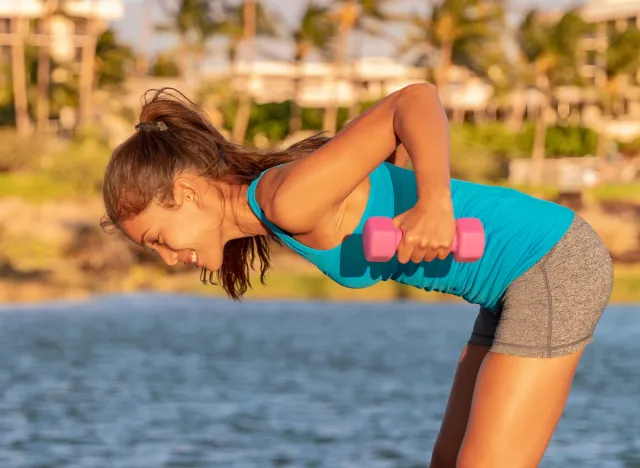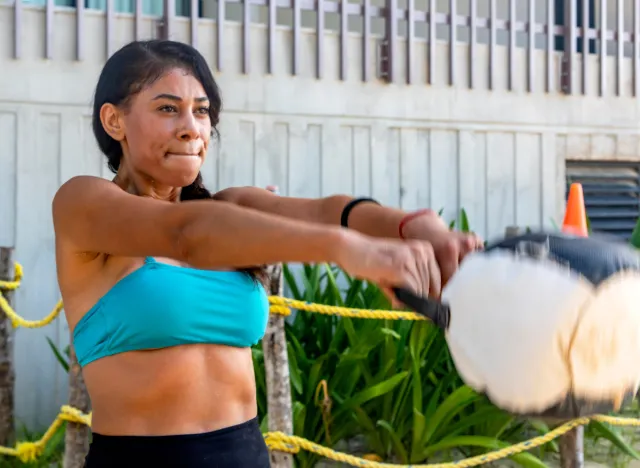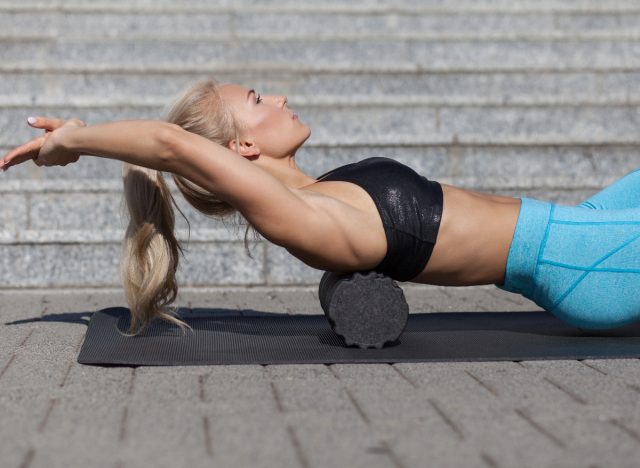6 Standing Exercises That Reverse Aging Faster Than Running After 50

The real magic of keeping your body feeling young happens when you move with purpose, build muscle that supports your joints, and train your body to stay strong, stable, and powerful. Strength, especially as we age, takes on a new identity. Moving well, standing tall, and keeping the energy and confidence that come from feeling capable in your own skin take priority.
After 50, your body changes, but that doesn’t mean your workouts should slow down. Standing exercises create a unique blend of balance, coordination, and full-body tension that helps preserve lean muscle, joint health, and bone density. These moves train your body to work as one unit, making every step, twist, and lift in your day easier.
Running certainly has benefits for your heart and endurance, but standing strength work gives you something running can’t: a foundation for aging well. It trains your posture, your core stability, and your ability to generate force safely and efficiently. That means you’ll not only look stronger but also feel more athletic, agile, and ready to take on anything.
The following six standing exercises help to achieve this. They build strength in the muscles that keep you upright, coordinated, and energetic. These moves challenge your balance, strengthen your entire body, and help you turn back the clock on how you move and feel every day.
Standing Exercise #1: Squats

Squats are a cornerstone of youth and longevity. They strengthen your glutes, quads, and core, which are essential for maintaining mobility and power as you age. Strong legs protect your knees, improve balance, and make daily activities like climbing stairs and getting up from a chair effortless. Regular squatting helps build the kind of functional strength that enables you to stay independent and active well into your later years.
How to Do It:
- Stand tall with your feet shoulder-width apart.
- Brace your core and keep your chest upright.
- Push your hips back and bend your knees to lower your body.
- Lower until your thighs are parallel to the ground or as far as your mobility allows.
- Drive through your heels to stand tall and squeeze your glutes at the top.
Recommended Sets and Reps: Perform 3 to 4 sets of 12 to 15 reps, resting 45 to 60 seconds between sets.
Best Variations: Goblet Squat, Bodyweight Pause Squat, or Wall Squat Hold.
Form Tip: Keep your knees aligned with your toes and distribute your weight evenly over your midfoot.
Standing Exercise #2: Farmer Carry

Few exercises build real-world strength like the Farmer Carry. It improves grip, posture, and total-body endurance. Each step challenges your core to stabilize your spine, while your shoulders and arms stay strong under tension. It’s one of the simplest ways to train balance, coordination, and muscular control, all of which are crucial for staying youthful and capable after 50.
How to Do It:
- Stand tall with a dumbbell or kettlebell in each hand at your sides.
- Engage your core and pull your shoulders slightly back.
- Walk forward in a straight line with small, controlled steps.
- Keep your head up and avoid leaning to one side.
- Continue for 20 to 40 yards, then rest and repeat.
Recommended Sets and Reps: Walk 3 to 4 rounds of 20 to 40 yards, resting 60 seconds between carries.
Best Variations: Single-Arm Carry, Suitcase Carry, or Overhead Carry.
Form Tip: Stay tall and tight from head to toe. Think of “walking proud.”
Standing Exercise #3: Push Press

The Push Press combines power and control. It strengthens your shoulders, triceps, and core while training your lower body to drive force upward. This dynamic, full-body motion boosts athleticism and coordination, helping maintain muscle fiber activity and reaction speed, two key traits that tend to decline with age.
How to Do It:
- Hold a pair of dumbbells at shoulder height with your palms facing each other.
- Bend your knees slightly and dip your hips.
- Explosively drive your legs and press the weights overhead.
- Lock out your arms, then lower the dumbbells under control.
- Reset your stance and repeat.
Recommended Sets and Reps: Perform 3 sets of 10 to 12 reps, resting 60 seconds between sets.
Best Variations: Single-Arm Push Press, Kettlebell Push Press, or Barbell Push Press.
Form Tip: Use your legs to initiate the press, not just your arms.
Standing Exercise #4: Deadlifts

The Deadlift is the ultimate anti-aging move. It builds strength in your hamstrings, glutes, and back, the muscles that support posture and protect your spine. Performing deadlifts keeps your body capable of lifting, carrying, and moving heavy objects safely. It’s one of the best ways to maintain bone density, joint integrity, and muscle mass as you get older.
How to Do It:
- Stand with your feet hip-width apart and a weight in front of you.
- Hinge at your hips while keeping your back flat.
- Grip the weight and tighten your core.
- Drive through your heels to stand tall, squeezing your glutes.
- Lower the weight under control back to the ground.
Recommended Sets and Reps: Perform 3 sets of 8 to 10 reps, resting 90 seconds between sets.
Best Variations: Kettlebell Deadlift, Romanian Deadlift, or Trap Bar Deadlift.
Form Tip: Keep your chest tall and spine neutral throughout the movement.
Standing Exercise #5: Bent-Over Rows

Bent-Over Rows strengthen your back, shoulders, and arms while reinforcing posture and spinal stability. They’re essential for maintaining upper-body balance and preventing the rounded posture that can come with age. Strong back muscles also support the shoulders and neck, reducing stiffness and improving daily movement quality.
How to Do It:
- Hold a dumbbell or barbell with both hands, palms facing down.
- Hinge at your hips until your torso is nearly parallel to the ground.
- Keep your core tight and spine flat.
- Pull the weight toward your torso, squeezing your shoulder blades together.
- Lower slowly and repeat.
Recommended Sets and Reps: Perform 3 sets of 10 to 12 reps, resting 60 seconds between sets.
Best Variations: Single-Arm Dumbbell Row, Kettlebell Row, or Inverted Row.
Form Tip: Lead with your elbows and keep your neck in a neutral position as you row.
Standing Exercise #6: Kettlebell Swings

Kettlebell Swings combine strength, power, and conditioning in one efficient move. They build explosive hip drive, strengthen your posterior chain, and challenge your heart rate for a cardio effect that rivals running. This movement enhances your ability to move quickly, absorb force, and stay powerful well into your later years.
How to Do It:
- Stand with feet slightly wider than shoulder-width and a kettlebell between your feet.
- Hinge at your hips and grip the handle with both hands.
- Swing the kettlebell back between your legs, keeping your chest lifted and your core engaged.
- Drive your hips forward to swing the bell up to shoulder height.
- Control the descent and repeat in a smooth, rhythmic motion.
Recommended Sets and Reps: Perform 4 sets of 15 to 20 reps, resting 60 seconds between sets.
Best Variations: Single-Arm Swing, Dumbbell Swing, or Alternating Swings.
Form Tip: Focus on hip drive, not arm strength. Let your legs do the work.
The Best Tips for Reversing Aging After 50

You can’t stop time, but you can slow its effects with smart, consistent movement. Reversing aging isn’t about turning back the clock. It’s about adding quality years filled with energy, strength, and vitality. These exercises do the heavy lifting, but your daily habits make all the difference. Pair your training with these key strategies to optimize your body’s performance.
- Train Regularly: Aim for 3 to 5 standing workouts each week. Consistency keeps your muscles and joints active, which helps fight off stiffness and weakness.
- Eat for Recovery: Fuel with protein-rich meals and plenty of fruits and vegetables to rebuild muscle and reduce inflammation.
- Prioritize Sleep: Deep rest supports hormone balance, muscle recovery, and mental clarity, all key ingredients for aging well.
- Stay Mobile: Regularly stretch or foam roll to keep your body moving freely and pain-free.
- Move with Intention: Every rep, walk, or carry should challenge your coordination and focus. Quality movement builds longevity.